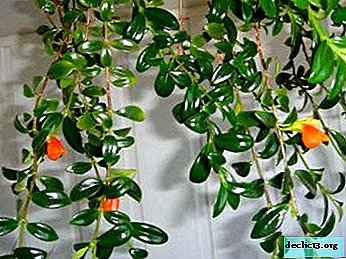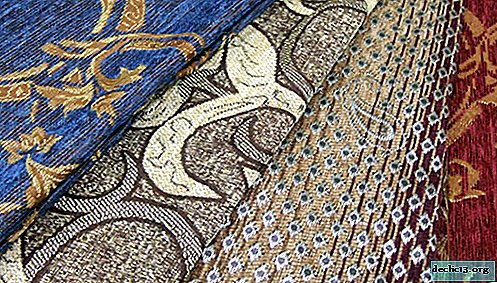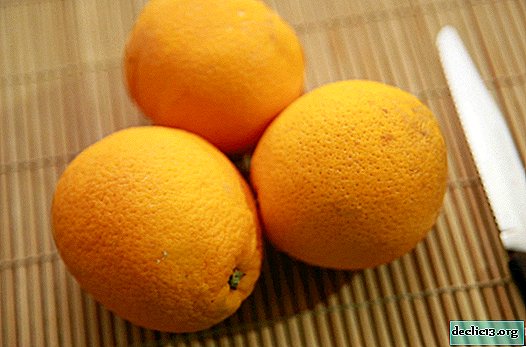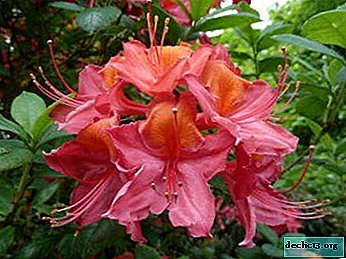What care is needed for hypocyte at home? Plant photo

Nematanthus (or hypocirrhoid is an outdated name, but no less popular from this) is a genus of flowering shrub plants belonging to the Gesneriaceae family.
The people have the name Golden Fish. It is an epiphyte, although due to its fleshy leaves, it looks like a succulent.
There are only a few dozen species that grow in the tropical forests of Brazil, but they can be found throughout South America.
In the article we will talk about the rules of care, show in the photo what hypocirrhoid looks like, and also tell you how to deal with diseases and pests.
General Provisions
Despite the unpretentiousness in leaving, nematanthus is not very popular among gardeners. People are simply afraid to breed exotic plants. In fact, he is not particularly demanding on leaving. If you provide it with the necessary conditions, there will be no problems. The most important thing to pay attention to when planting a plant is:
- high illumination of the room;
- sufficient humidity.
There are other nuances, for example, its dependence on the time of year.
Photo
In the photo you can see what a hypocirrhoid flower or nematanthus looks like:





Watering
During the growing season, hypocyte needs the most active soil moisture.. Water for irrigation is always used sludge, room temperature. In warm seasons, from spring to summer, the plant is watered abundantly. It is also important to spray the air around the plant, which qualitatively affects its flowering.
It is not recommended to allow a direct hit of water on inflorescences and foliage - this may affect the appearance of the flower. In the tropics, where the plant comes from, there is high humidity all year round, so you need to understand that the higher the temperature in your home, the more air should be moistened.
In winter, watering is moderate, but with a spray of air it is better to wait or reduce it to a minimum. To maintain the necessary humidity in the room, use a pallet with wet expanded clay, placing it in the immediate vicinity of the flower, or trays with pebbles. The lower the room temperature, the less air should be humidified.
Before re-watering the hypocyte, you need to give time to dry a little. Do not allow the complete drying of the soil.But even if you forget to water the flower and the soil dries completely, you will notice that it is quite drought tolerant and can last an amazingly long time without water.
Thick, juicy leaves of nematanthus retain water in themselves and prevent the plant from dying for a long time.
As a fairly hardy plant, nematanthus can tolerate dry air. But even in this case, gardeners should not relax, because with very low humidity the plant will most likely not bloom at all. If it produces several buds, they will fall prematurely before opening.
Temperature mode
The temperature regime directly depends on the season. In the period from summer to spring, a room temperature of 20 to 25 ° C is permissible. In summer it is allowed even higher, but in this case it should be reduced at night to 12 ° C. The flower needs a break from the heat. You should not be afraid of sudden changes in temperature at night: hypocirrh can tolerate cold quite easily, although not for too long.
 In winter, the plant will feel comfortable even at a temperature of 12 ° C during the day.. At the same time, remember: under such conditions, air humidification should be completely excluded, since at low temperatures the plant has a state of "sleep mode", which is why all life processes are slowed down.
In winter, the plant will feel comfortable even at a temperature of 12 ° C during the day.. At the same time, remember: under such conditions, air humidification should be completely excluded, since at low temperatures the plant has a state of "sleep mode", which is why all life processes are slowed down.
With the onset of cold weather, you may find that your nematanthus loses its former luster, and its flowers can completely crumble. Do not despair, because in this way your plant is trying to say that it needs rest.
If you want to support your flower and help it, place it in a part of your room where the air temperature is much cooler and the daylight drop is not so significant - then the plant will be able to rest from direct sunlight and regain its strength.
Lighting
At any time of the year, the light in a room with a nematanus should be bright, but at the same time scattered. Direct sunlight should preferably be avoided, especially in the summer and if the pot with the plant is located on the south window. In winter, it is advisable to observe daylight hours of at least 12 hours.
The location of the window should also be considered. If the windows face north, the flowers must be provided with artificial light: at least 16 hours in the summer and about 14 hours in the winter.
IMPORTANT! Always make sure your plant is well protected from the hot, midday summer sun.The soil
Use only quick-drying, non-moisture retaining, neutral soil. You can buy a ready-made bio-soil in a specialized store, or cook it yourself. This will require two parts of peat and leaf land, one part of sand and humus.
Mix all the components together and add a little vermiculite, charcoal, moss and pine bark, which will provide the soil with the necessary friability and airiness.
Do not tamp the ground too tightly! The hypocirrhoid has small root systems that are very susceptible to rot. Layering in the soil is necessary to avoid stagnation of water in it.
Pot selection
 The pot for nematanthus should not be too spacious, but must have large drainage holes.
The pot for nematanthus should not be too spacious, but must have large drainage holes.
In case of transplantation, the pot is taken a little larger than the previous one. Young plants are transplanted annually, and once the flower reaches four years of age - once every two years.
It is possible to transplant several cuttings at once into one pot, arranging shoots in a circle. It is advisable to transplant along with a part of the land held by the roots. Try not to hurt them, as the roots grow very slowly. Before transplanting, pot containers should be thoroughly decontaminated to avoid infection of the flower with parasites.
Pruning
It is usually pruned in early spring if the plant has lost part of its leaves or has grown excessively during the winter. Or in the fall, preparing a flower for a state of winter dormancy, removing weakened shoots, and also after the plant has flowered. Pruning leads to improved bushiness and splendor of the flower.
Top dressing
Fertilizer is an important factor in the healthy development of a flower. During the period of active vegetation, a balanced mineral fertilizer is necessary, which is a ready-made solution. Enter it in the bio-soil no more than once every two weeks. Begin less often in the fall, and stop completely in the winter.
Use top dressing only after watering! The soil must be moistened so that the fertilizer does not harm the sensitive roots of the hypocirrh.If the flower grows in open ground
When caring for a plant in open ground, it is imperative to take into account its natural growing conditions. Nimatanthus, being a tropical plant, where seasonal temperature fluctuations are almost imperceptible, does not like prolonged temperature changes.
It is worth considering that the inhabitants of the subarctic or sharply continental zone (which include Siberia and the Russian Far East) cannot grow this plant in the garden in the open air. Usually the winter temperature, even in the warmest cities of the country, often drops below five degrees Celsius, and for nematanthus this is the limit.
Of course, the plant can be cleaned for the winter in a warm place, but this option also seems problematic: hypocirrha does not like frequent transplants.
How to prepare for winter?
 Care in the winter at home is not difficult. The plant during the cold weather is in a sluggish state of growth, therefore, does not require special care.
Care in the winter at home is not difficult. The plant during the cold weather is in a sluggish state of growth, therefore, does not require special care.
It is important to remember that the more a pot with a plant is located in a cooler place, the less watering is required. If the temperature reaches the lowest possible temperature acceptable for nematanthus (12 ° C), then watering should be suspended for the whole winter.
Diseases and their prevention
Subject to all the above norms for the cultivation of nematanthus, problems with diseases should not arise. If this does happen, pay attention to the symptoms.
The plant turns yellow
The leaves may turn yellow and brown if they are too long in direct sunlight, excessive fertilizer and watering, including too cold water. To prevent this, always have stock of sludge at room temperature, and from the sunshine, cover the flowers with a curtain. Fertilize the fertilizer temporarily until the flower has fully recovered.
Fungus
Fungi can affect nematantus if the room has insufficient ventilation, too high temperature and excessively humidified air. To prevent this, it will be enough to ventilate the rooms daily, avoiding drafts.
If the plant is still ill, treat it with fungicidal preparations, for example Fitosporin.Foliage
Leaves may crumble upon hypothermia of the flower and waterlogging of the soil. Prevention in this case is very simple: do not let the temperature in the room drop below 12 ° C.
Sluggish leaves
Fading leaves should be a signal that the plant is overloaded with mineral fertilizers. Try to wait two weeks with top dressing and watch the leaves. If the situation does not change, then most likely the humidifying measures in the room are not followed. Spray the room in the immediate vicinity of the pot without touching the plant.
Pests
Despite the resistance to pests, it happens that the hypocyte is attacked by parasites. The probability of damage depends on the health and proper development of the flower. With improper care, the plant can become depleted and weaken, while becoming a favorable environment for the development of various pests.
Aphid
 Affected aphids of the plant look twisted and dry due to the exhaustion of juices. At the same time, the plant is affected by viruses, which are then difficult to fight. To be sure that it is aphid, you need to carefully examine the stems and leaves of the plant: small insects may not be immediately noticeable. Methods of controlling aphids include spraying the plant with preparations containing permethrin.
Affected aphids of the plant look twisted and dry due to the exhaustion of juices. At the same time, the plant is affected by viruses, which are then difficult to fight. To be sure that it is aphid, you need to carefully examine the stems and leaves of the plant: small insects may not be immediately noticeable. Methods of controlling aphids include spraying the plant with preparations containing permethrin.
As protection prophylaxis, it is necessary to carefully monitor the healthy growth of the flower, pruning, fertilizing and creating moisture so vital to it.
Mite
Ticks, like aphids, feed on the juices of fleshy leaves, which is also detrimental to the flower. You can deal with them in similar ways and mechanically, removing insects with a cotton pad or swab.
Mealybug
A mealybug defeat cannot be confused with anything. If you find white cotton-like lumps located in the axils of the leaves, then remove them mechanically. To do this, moisten a cotton pad or cloth with alcohol.
Thrips
Thrips is one of the most common phyto-pests. Outwardly resembles gray dust due to its very small size. It feeds on plant juices. Fight them with drugs containing insecticides. First remove the “black dots" manually, as in the case of combating other pests.
Conclusion
Nemantanthus or Hypocirth - an unusually bright plantcapable of blooming continuously up to four consecutive months, creating comfort in your home. With proper watering, adequate lighting, satisfactory humidity, and regular nutrition during the growing season, you will be rewarded with beautiful foliage and flowers for years to come.
But even if it does not bloom, the glossy foliage of the plant still makes it an attractive and worthy competitor to other potted flowers, more familiar to us.

















